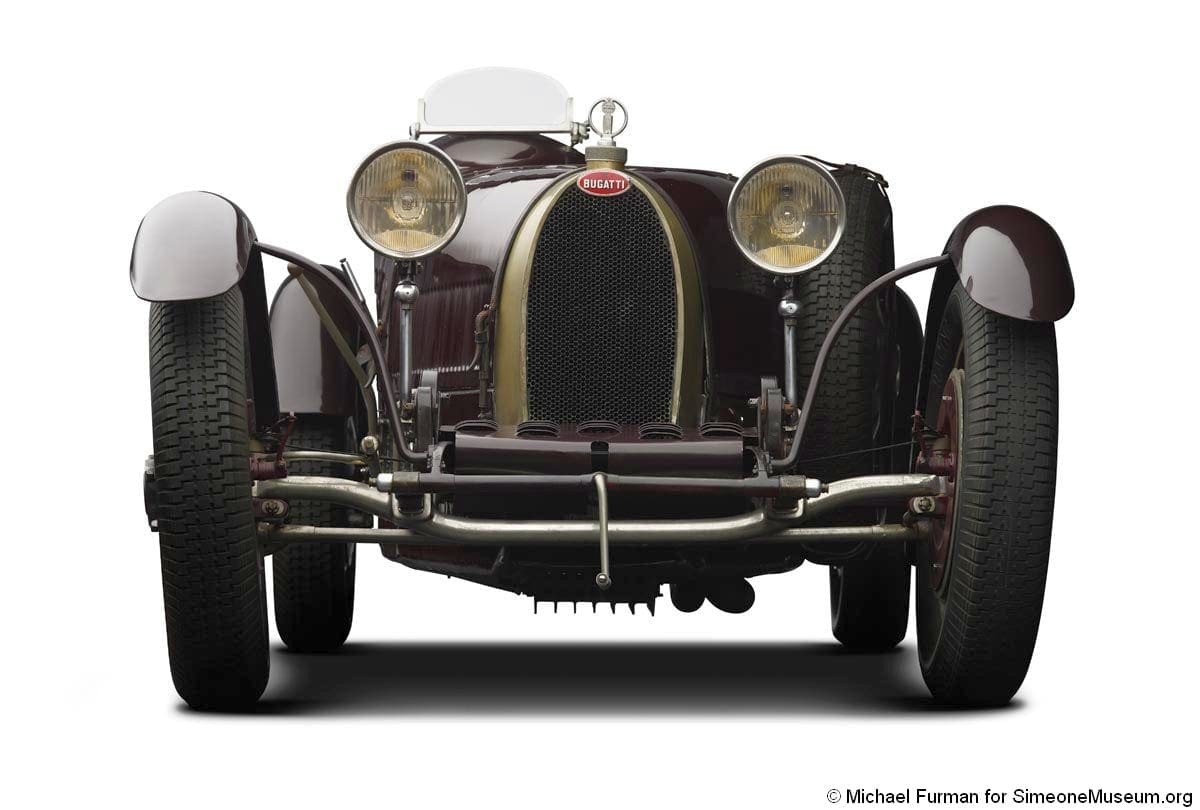These cars won the Targa Florio 4 consecutive years. Our car is recognized as one of the most original, unrestored examples in existence.
THESE CARS
It is redundant for most readers to review the racing history of the Type 35 Bugatti, probably the most active, with over 2000 wins in a variety of competitions, mostly small, throughout Europe in the late-1920s and early 1930s. Artistically, the cars were beautiful mechanical creations with legendary engineering, attractive finishes, innovative devices such as safety wires threaded through the fasteners, hollow polished axles, and an overall classical elliptical design.
The archetypal car, the 2-liter type 35 such as in the collection, gradually metamorphosed from a combination race and road car (with road equipment), to pure racing versions with larger engines and supercharger ending in the powerful Type 35 B and Type 51. Though these cars had similar chassis, they became bulkier than the original 1650 pound Type 35 car with larger radiators and much more robust engines. The single overhead cam engine on the original Type 35 capable of 95 horsepower ultimately became a double overhead cam version in the Type 51 which competed effectively with the great 8-cylinder Alfa Romeo race cars.
A purposeful performance automobile with no compromise for comfort, the surfeit of louvers throughout, the unique cast aluminum wheels, engine turning and hand scraping on some unpainted parts, and the overall noise and smell orchestrated an aesthetic gem which is why so many were sold to amateur and professional racing men and women alike. As the Bugatti sales brochure shows, they could purchase the Type 35 with road equipment (fenders and lights), whereas the later models were pure race cars, road equipped by the drivers themselves if necessary.
Loud, smelly, and uncomfortable they were not the ideal road car, a fact not lost on the Alfisti who often eschew the idea that Bugatti were any competition to their Italian favorites. But, as a cult car, Bugatti always has, and still maintains a panache which no other sports car can manage. Witness the many clubs worldwide, the glut of books still being produced regularly and the renaissance of the name in the form of the most expensive and most powerful road car one can buy at the time of this writing. Interest in their classicism is compounded because someone can purchase virtually any part of these frangible creations new from the various specialist shops who can make you a “tool room” copy if so desired.
OUR CAR
According to factory records, they sent this car to Ed d’Matarazzo, a Bugatti agent in Sao Paolo, Brazil in 1926. It was said Ettore preferred to sell outside of France and gave foreign dealers a better price. For instance, d’Matarazzo ordered 15 Types 35 in June 1926, for which he paid 35,000 Francs each as a rolling chassis while the magasin in Paris had to pay 39,200 Francs for the same car at the same time.
This car is a full-fledged Type 35, 2.3 liter with the roller bearing crankshaft. It is not the “imitation” type. It next appears, of all places, in Edward Weston’s files where he photographed it while owned by his photographer friend, Paul Ivanos, who bought the car in Buenos Aires in the early 1930s. In Weston’s photograph, it appears to have the same Scintilla lights it wears. Reliable sources say his riding mate in this photo is actress Claudette Colbert. In a letter from Bunny Phillips to Andy Rheault, he states that, in 1932, he overhauled the engine and sold the car to Tom Ince. From there, it passed on to a few other owners, including Bob Morgan, who drove the car across the USA to the East Coast and from there on, Bunny indicates that he lost track of it. It would appear that around this time, it was owned by Bill Wonder, an outstanding race driver, auto enthusiast, and an octogenarian who still has a clear mind and great energy devoted to the wonderful cars he loves and owned. In this letter, Bunny also comments, “The car was always pretty stark and original. It had no starter or generator. The engine was a straight T35 two liters and always trouble free as long as I knew it”.
The car, ultimately, ended up in the hands of Bill Serri. It has a dark maroon paint job, but apparently it was originally Bugatti blue. Bill had a set of Bugatti front fenders, which he claimed came with the car, but which he almost discarded because he wanted it to be a Grand Prix car and not a sports car. He sold the car off, but then got it back again prior to selling it to me in 1982.
Bill’s penchant for originality attracted him to this car. The original engine turned dash finish was preserved, and it is typical of the hand type technique used at the time, not sterilized by modern machine methods to reproduce the damascening effect. He went to the trouble of maintaining the tiny cam-driven pump which repressurizes the fuel tank as the car runs. He always crank started it. All instruments and trim appear to be original. The car was always tatty, but quite acceptable with no running problems. When Serri rebuilt the engine, he replaced the ball bearings with needle bearings, common at the time to increase the engine’s longevity between repairs.
Assuming that the lights and front fenders that came with the car were of the period, I had a set of rear fenders made and we present it in an early 1931 configuration, about the time Ivanos got the car. It appears as factory road equipped car would look in the early 1930s. It presents in the Targa Florio exhibit of the museum because so many of these early Type 35s were successful in that great Sicilian race which they won annually from 1925 to 1929. It continues to run flawlessly with really no restoration except reshaping the original tail, without the addition of any metal, where it had been bumped in a bit.
In 2000, The Franklin Mint Company produced a 1:24 scale model of our car, which was sent over to their factory on the suggestion of Andy Rheault. On reviewing the model for the Bugatti Club Magazine Andy wrote, “It should be noted that the model is based on Fred Simeone’s Type 35 chassis, 4752, which is considered one of the most original-unrestored-GP Bugatti in existence”.

Almost 80 years after its introduction, the Bugatti Type 35 remains one of the most iconic and historically significant cars to have ever raced.
SPORTSCARMARKET.COM


















